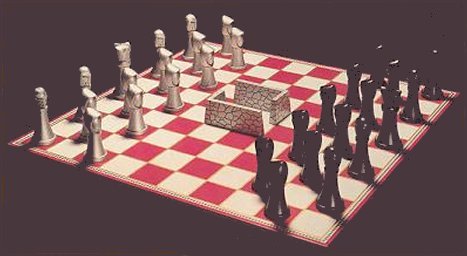Courtyard
Editor's Note: Courtyard was invented by Leonard
Kalich Sr., and is (or was) a game distributed by FunDynamics. Having made
reasonable efforts to contact them, we can only assume they have gone out of
business. However this may not necessarily be true, so if anyone knows of how we
could contact this company or the inventor, please let us know so we can request
permission to continue publishing this description of the rules. Thank you.
John Ayer
writes:
This is another crossover game. It
was invented by Len Kalich (Leonard Kalich, Sr.) of Troy, Michigan. He
meant to combine the ease of learning checkers with the challenge and variety of
chess. The following abstract of the rules is based on material copyrighted
1984, 1986, and 1987.
The board is ten squares on each side, checkered white and dark, except that the
four central squares are replaced by a walled courtyard. Each player has a
dark square at the right-hand end of the nearest row. Play is on dark
squares only. There are two gaps in the courtyard wall, one square wide,
on the left-hand side as each player faces the courtyard. It is each
players goal to move his king into the courtyard through the entrance on his
opponents side of the board, and so to win the game. A king cannot enter
through the gate on his own side, and no other piece can enter the courtyard
under any circumstances.
Each player has fifteen playing pieces: a king, four guards, and ten serfs.
Each player starts with his king on the central dark square on his back row,
flanked by his four guards, with the serfs occupying the next two rows.
Capture is by jumping over a piece on an adjacent square to the square
immediately beyond, which must be vacant. Capture is mandatory.
Sequential captures are possible (and mandatory). The only way to avoid
this necessity is to move another of ones own pieces to the square that the
capturing piece would land on (if the player with the move can do this).
If a player fails to make a possible capture, his opponent removes the piece
that could have captured, and then makes his own move. Removing the piece
that could have captured is also mandatory. No piece can ever jump another
piece of its own color.
The king moves one square in any of the four diagonal directions. He can
capture opposing guards and serfs. He cannot capture the opposing king.
The king may capture an enemy piece by a leap that lands him in the courtyard by
the right gate. If a players king is captured, the game continues until
the opposing king enters the courtyard or is captured (making a tie).
The guard moves one or two squares in any of the four diagonal directions.
If a guard moves two squares, they must be in the same direction. He cannot
move one square and then make a leap in the same move. A guard can capture
any opposing piece.
The serf moves one square diagonally forward right or forward left, and can
capture any opposing piece or pieces, but only by leaping diagonally forward.
A serf that reaches the opposite edge of the board remains there inactive unless
its player spends a move returning it to any vacant dark square on his first
row.
Each player makes one move, according to the rules above, per turn. Which
player moves first is determined by lot (alternatively, players or clubs can
agree that white moves first). A player who has pieces on the board but
cannot make a legal move loses, provided the other player can still move.
A player who loses all his pieces loses the game. Conceding a game is done
by picking up the opponents king and setting it down in the courtyard.
The proprietary pieces are quite handsome, and enhance the pleasure of the game.
The dark square are dark red; ox-blood might be about right. Thin golden
lines separate the squares. Golden spearheads on two squares point to the
entrances to the courtyard, which is black, ornamented with a large uncial C in
golden outline, and furnished with removable plastic walls shaped to suggest
plastered stone.
Courtyard was published by FunDynamics in 1983. (Ed.)

photo credits: http://www.abstractstrategy.com/courtyard.html
